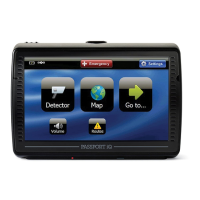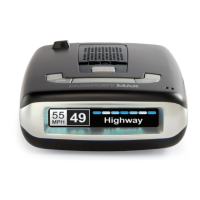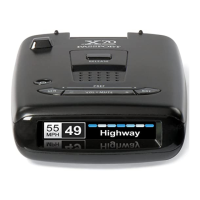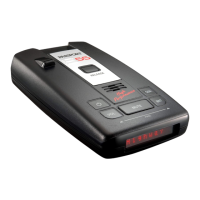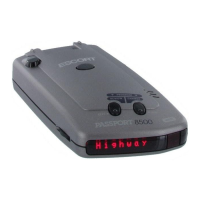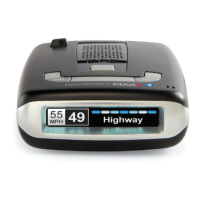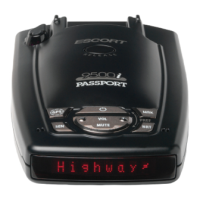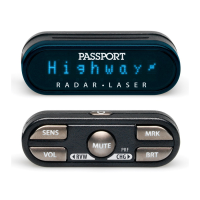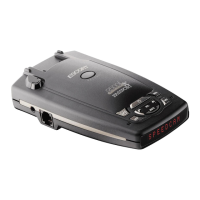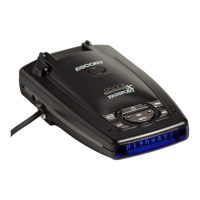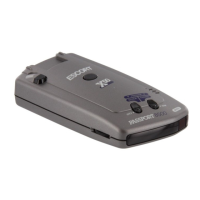1312
Understanding Your Detector
Interpreting Alerts
Although PASSPORT has a comprehensive warning
system, only experience will teach you what to expect
from your detector and how to interpret what it tells
you. The specific type of radar being used, the type of
transmission (continuous or instant-on) and the
location of the radar source affect the alerts you
receive.
How Radar Works
Traffic radar, which consists of microwaves, travels in
straight lines and is easily reflected by objects such
as cars, trucks, and even guardrails and overpasses.
Radar works by directing its microwave beam down
the road. As your vehicle travels into range, the
microwave beam bounces off your car, and the radar
antenna looks for the reflections. Using the Doppler
principle, the radar equipment then calculates your
speed by comparing the frequency of the
reflection of your car to the original
frequency of the beam sent out.
Traffic radar has limitations, the most significant
of these being that it typically can monitor only
one target at a time. If there is more than one
vehicle within range, it is up to the radar operator
to decide which target is producing the strongest
reflection. Since the strength of the reflection is
affected by both the size of the vehicle and its
proximity to the antenna, it is difficult for the radar
operator to determine if the signal is from a sports car
nearby or a semi truck several hundred feet away.
Radar range also depends on the power of the radar
equipment itself. The strength of the radar unit’s
beam diminishes with distance. The farther the radar
has to travel, the less energy it has for speed
detection.
Because intrusion alarms and motion sensors often
operate on the same frequency as X and K band
radar, your detector will occasionally receive non-
police radar signals. Since these X band transmitters
are usually contained inside of a building or aimed
toward the ground, they will generally produce much
weaker readings than will a true radar encounter. As
you become familiar with the sources
of these pseudo alarms in your daily
driving, they will serve as
confirmation that the device’s radar
detection abilities are fully
operational.
CAUTION: Overconfidence in an unfamiliar area can be
dangerous. Likewise, if an alert in a commonly
traveled area is suddenly stronger or on a different band
than usual, speed radar may be set up nearby.
Alert Explanation
Detector begins to sound slowly; rate of alert You are approaching a continuous radar source
increases until it becomes a solid tone. The aimed in your direction.
signal meter ramps accordingly.
Detector emits short alerts for a few seconds An instant-on radar source is being used ahead
then falls silent, only to briefly alert and fall of you and out of your view.
silent again.
Detector suddenly sounds a continuous tone An instant-on radar or laser source is being used
for the appropriate band received. nearby. This kind of alert requires immediate
attention.
Detector sends a brief laser alert. Laser is being used in the area. Because laser is
inherently difficult to detect, any laser alert may
indicate a source very close by.
Detector receives weak signals. Signals may be A moving patrol car with continuous radar is
a little stronger as you pass large, roadside overtaking you from behind. Because these
objects. Signals increase in frequency. signals are reflected (reflections are increased by
large objects), they may or may not eventually
melt into a solid point, even when the patrol car
is directly behind you.
Detector alerts slowly for a while then abruptly You are approaching a radar unit concealed by a
jumps to a strong alert. hill or an obstructed curve.
Detector alerts intermittently. Rate and A patrol car is traveling in front of you with a
strength of alerts may be consistent or vary radar source aimed forward. Because signals are
wildly. sometimes reflected off of large objects and
sometimes not, the alerts may seem inconsistent.
Detector alerts intermittently; rate and A patrol car is approaching from the other
strength of signal increases with each alert. direction, sampling traffic with instant-on radar.
Such alerts should be taken seriously.
Detector gives an X band alert intermittently. You are driving through an area populated with
radar motion sensors (e.g., door openers or
burglar alarms). Since these transmitters are
usually contained inside buildings or aimed
toward or away from you, they are typically not
as strong or lasting as a real radar encounter.
The following examples will give you an introduction
to understanding your detector’s warning system for
radar and laser alerts.
How POP Works
POP works by transmitting an extremely short burst,
within the allocated band, to identify speeding
vehicles in traffic. Once the target is identified, or
“popped,” the gun is then turned to its normal
operating mode to provide a vehicle tracking history
(required by law).
NOTE: According to radar gun manufacturers, tickets
should not be issued in pop mode.
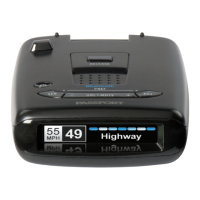
